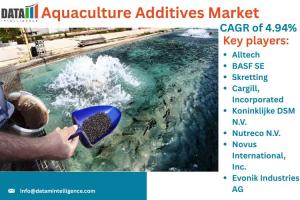Aquaculture Additives Market Surges as Demand for Sustainable Fish Farming Intensifies 2025 | DataM Intelligence
Aquaculture Additives Market Advances in U.S. and Japan on Innovation, Regulation, and Sustainability
The Aquaculture Additives Market is growing rapidly, driven by rising seafood demand, sustainable farming practices, and innovations enhancing fish health and yield.”
SEATTLE, WA, UNITED STATES, September 9, 2025 /EINPresswire.com/ -- Market Overview:— DataM Intelligence
The Global Aquaculture Additives Market is expanding steadily, reaching USD 10.89 billion in 2023, with expectations to grow to USD 16.10 billion by 2031, at a 4.9% CAGR.
In the United States, the aquafeed additives segment generated USD 377.5 million in 2024, and is projected to reach USD 481.1 million by 2030, at a 4% CAGR.
In Japan, the market is smaller but growing with revenue of USD 18.7 million in 2024, expected to reach USD 23.8 million by 2030, at a 4% CAGR.
These figures reflect rising seafood consumption, sustainability demands, and advances in additive technology.
To Download Sample Report Here: https://www.datamintelligence.com/download-sample/aquaculture-additives-market
Recent Developments:
Industry Trends
• In the U.S., the rise of **functional nutrients such as probiotics, prebiotics, essential oils, amino acids, and vitamins **is gaining traction among additive types
• North America leads the global aquaculture additives market share, accounting for over one-third of total revenue.
• In Japan, feed acidifiers are the largest additive segment by revenue, while essential oils & natural extracts are the fastest-growing category.
Product Innovation:
• Sustainable innovation includes BioKind’s UK-made additive, produced via natural fermentation of agricultural waste a low-carbon, toxin-free alternative.
Regulatory Movement:
• In the U.S., NPDES regulations under the Clean Water Act govern wastewater discharge in aquaculture systems, influencing additive use and formulation strategies.
Market Segmentation:
By Additive Type: Antibiotics, Antibiotics, Vitamins, Amino Acids, Minerals, Enzymes, Probiotics and Prebiotics, Binders, Others.
By Species: Salmon, Tilapia, Carp, Catfish, Trout, Shrimp, Others.
By Functionality: Disease Prevention and Control, Growth Promotion, Feed Efficiency Improvement, Water Quality Management, Others.
By Form: Liquid, Dry, Powder, Granules, Others.
By Distribution Channel: Supermarkets/Hypermarkets, Online Retail, Specialty Stores, Others.
By Region: North America, Latin America, Europe, Asia Pacific, Middle East, and Africa.
Buy Now & Unlock 360° Market Intelligence: https://www.datamintelligence.com/buy-now-page?report=aquaculture-additives-market
Strategic Insights (DataM Perspective):
At DataM Intelligence, we see three strategic imperatives:
1. Innovation Leap – The move toward natural, functional ingredients signals a shift from basic feed components to value-adding formulations.
2. Regulatory Planning – U.S. environmental compliance and consumer-driven demand for sustainable seafood are shaping additive selection and R&D.
3. Focused Market Adoption – Japan, though a smaller market, offers early-mover opportunities in automating feed delivery and environmentally aligned products.
Key Takeaways:
Strategic Focus: Business Implication
Steady Growth: U.S. market grows at 4% CAGR; Japan aligns at 4% scale local production and outreach.
Natural Additives: Consumers favor functional nutrition; innovate toward prebiotics, essential oils, probiotics.
Regulatory Edge: Compliance-ready formulations strengthen positioning in regulated markets.
Japan-specific Strategy: Focus on automation and efficient feed delivery in a technologically advanced market.
Market Key players:
1. Archer Daniels Midland Company
2. Alltech
3. BASF SE
4. Skretting
5. Cargill, Incorporated
6. Koninklijke DSM N.V.
7. Nutreco N.V.
8. Novus International, Inc.
9. Evonik Industries AG
10. Kemin Industries, Inc.
Use Cases & Case Spotlight:
• BioKind’s Sustainable Protein Additive: This UK-based innovation showcases how waste-derived fermentation products improve sustainability and align with eco-conscious markets.
• Japan’s Acidifier Adoption: Feed acidifiers are prominent in Japan’s aquaculture sector, enabling better fish health and feed efficiency demonstrating local demand preferences.
DataM Recommendations:
1. Develop Natural-Compound Additives – Prioritize R&D in prebiotics, essential oils, and amino acids to meet evolving demand.
2. Engage with Regulators Early – Align formulations with environmental standards like NPDES to ensure adoption ease.
3. Build Japan-Modulated Offerings – Design acidifier-forward solutions integrated with feeding automation for Japanese producers.
4. Leverage Bio-Innovation for Branding – Use green credentials (e.g., fermentation-based production) to differentiate in saturated markets.
Unlock 360° Market Intelligence with DataM Subscription Services: https://www.datamintelligence.com/reports-subscription
Conclusion:
The Aquaculture Additives Industry is entering a mature growth phase, with strategic opportunities emerging in both the United States and Japan. Growth is driven by functional ingredient innovation, regulatory alignment, and sustainability imperatives.
DataM Intelligence holds that companies who prioritize natural solutions, compliance-ready formulas, and regionally tailored offerings will lead in this evolving market.
Related Reports:
Aquaculture Fertilizer Market
Aquaculture Feed Extrusion Market
Sai Kiran
DataM Intelligence 4Market Research
+1 877-441-4866
Sai.k@datamintelligence.com
Visit us on social media:
LinkedIn
X
Legal Disclaimer:
EIN Presswire provides this news content "as is" without warranty of any kind. We do not accept any responsibility or liability for the accuracy, content, images, videos, licenses, completeness, legality, or reliability of the information contained in this article. If you have any complaints or copyright issues related to this article, kindly contact the author above.

